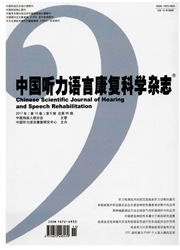

 中文摘要:
中文摘要:
目的:探讨神经纤维瘤听力下降患者人工耳蜗植入手术可行性及疗效。方法对一例多发性神经纤维瘤伽马刀术后患者带瘤行CS-10A人工耳蜗植入,术前和术后3个月分别进行裸耳/助听听阈评估、单音节和双音节言语识别测试。结果患者术前右侧重度、左侧极重度感音神经性聋,术前言语识别率左耳最大声输出患者无反应,右耳最大单音节词言语识别率为12%,双耳双音节词言语识别率均为0%。听觉行为分级量表为2级。患者右侧成功植入人工耳蜗。术后3个月助听后声场评估右耳(人工耳蜗植入耳)平均听力42.5 dB HL,单音节词最大言语识别率为64%,双音节词最大言语识别率为47%,听觉行为分级量表为7级。结论在影像学证明听神经完整的情况下,神经纤维瘤伽马刀术后重度聋患者可植入人工耳蜗,以提升听力水平。
 英文摘要:
英文摘要:
Objective To explore the safety and efficacy of cochlear implantation in a neuroma resection patient with hearing loss. Methods One patient after bilateral acoustic neuroma resection by Gamma knife surgery received a CS-10A cochlear implant in right ear. Postoperative performance including unaided/aided hearing thresholds and monosyllable and disyllable recognition rates was evaluated and compared with the preoperative performance. Results The patient suffered a severe hearing loss in the right ear and a profound hearing loss in the left ear. The preoperative monosyllable recognition rates were 0% and 12% for the left and right ear, respectively. The preoperative disyllable recognition rates were 0% for both ears. The preoperative CAP score was 2. Three months after cochlear implantation, the average aided hearing threshold of the right ear (implanted ear) was 42.5 dB HL. The postoperative monosyllable recognition rate was 64% and disyllable recognition rate was 47%. The postoperative CAP score was 7. Conclusion Cochlear implantation is a safe and effective approach to improve the hearing of patients after acoustic neuroma resection by Gamma knife surgery if the acoustic nerve is intact according to the preoperative imaging tests.
 同期刊论文项目
同期刊论文项目
 同项目期刊论文
同项目期刊论文
 期刊信息
期刊信息
